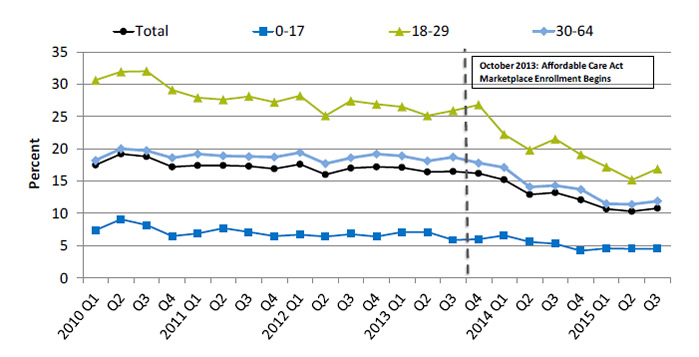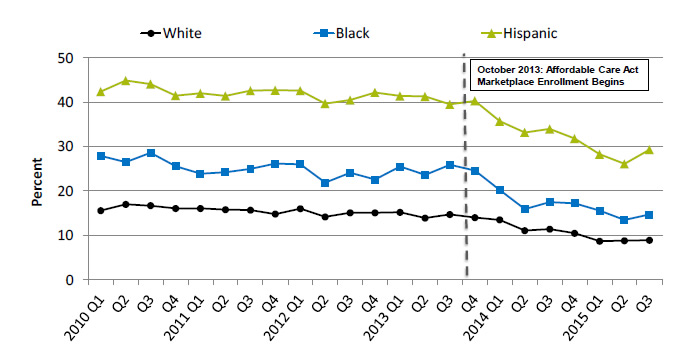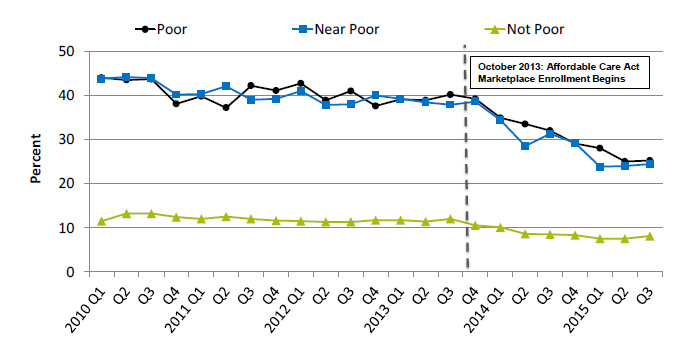- Access to health care means having "the timely use of personal health services to achieve the best health outcomes" (IOM, 1993).
- Access to health care consists of four components (Healthy People 2020):
- Coverage: facilitates entry into the health care system. Uninsured people are less likely to receive medical care and more likely to have poor health status.
- Services: Having a usual source of care is associated with adults receiving recommended screening and prevention services.
- Timeliness: ability to provide health care when the need is recognized.
- Workforce: capable, qualified, culturally competent providers.
Coverage
- Health insurance facilitates entry into the health care system.
- Uninsured people are less likely to receive medical care and more likely to have poor health status (Healthy People 2020).
- Many people rely on public health insurance, such as Medicaid.
- Public health insurance also includes Children’s Health Insurance Program (CHIP), State-sponsored or other government-sponsored health plans, Medicare, and military plans.
- For access measures in this chartbook, a small number of people were covered by both public and private plans and were included in both categories.
Measures of Coverage
- People under age 65 without health insurance coverage at the time of interview by:
- Age.
- Race/ethnicity.
- Poverty status.
Uninsurance, by Age
People under age 65 who were uninsured at the time of interview, by age, 2010-2015 Q3

| Quarter | Total | 0-17 | 18-29 | 30-64 |
|---|---|---|---|---|
| 2010 Q1 | 17.5 | 7.4 | 30.6 | 18.2 |
| Q2 | 19.2 | 9.1 | 31.9 | 20 |
| Q3 | 18.8 | 8.2 | 32 | 19.7 |
| Q4 | 17.2 | 6.5 | 29.1 | 18.6 |
| 2011 Q1 | 17.4 | 6.9 | 27.9 | 19.2 |
| Q2 | 17.4 | 7.7 | 27.6 | 18.9 |
| Q3 | 17.3 | 7.1 | 28.1 | 18.8 |
| Q4 | 16.9 | 6.5 | 27.2 | 18.7 |
| 2012 Q1 | 17.6 | 6.7 | 28.2 | 19.4 |
| Q2 | 16 | 6.4 | 25.1 | 17.7 |
| Q3 | 17 | 6.8 | 27.4 | 18.6 |
| Q4 | 17.2 | 6.4 | 26.9 | 19.2 |
| 2013 Q1 | 17.1 | 7.1 | 26.5 | 18.9 |
| Q2 | 16.4 | 7.1 | 25.1 | 18.1 |
| Q3 | 16.5 | 5.9 | 25.9 | 18.7 |
| Q4 | 16.2 | 6 | 26.8 | 17.8 |
| 2014 Q1 | 15.2 | 6.6 | 22.2 | 17.1 |
| Q2 | 12.9 | 5.6 | 19.8 | 14.1 |
| Q3 | 13.2 | 5.3 | 21.5 | 14.3 |
| Q4 | 12.1 | 4.2 | 19.1 | 13.7 |
| 2015 Q1 | 10.7 | 4.6 | 17.2 | 11.5 |
| Q2 | 10.3 | 4.5 | 15.2 | 11.4 |
| Q3 | 10.8 | 4.5 | 16.9 | 11.9 |
October 2013: Affordable Care Act Marketplace Enrollment Begins.
Key: Q = quarter.
Source: National Center for Health Statistics, National Health Interview Survey, January 2010-September 2015.
Note: For this measure, lower rates are better. Data available for 2015 quarters 1-3 only. Quarter 3 data were made available after the release of the 2015 National Healthcare Quality and Disparities Report and 5th Anniversary Update on the National Quality Strategy.
- Trends:
- From January 2010 to September 2015, the percentage of people under age 65 who were uninsured at the time of interview decreased from 17.5% to 10.8%.
- The percentage of people who were uninsured at the time of interview decreased for all age groups under age 65. Adults ages 18-29 experienced the largest declines.
Uninsurance, by Race/Ethnicity
People under age 65 who were uninsured at the time of interview, by race/ethnicity, 2010-2015 Q3

| Race/Ethnicity | White | Black | Hispanic |
|---|---|---|---|
| 2010 Q1 | 15.6 | 27.9 | 42.4 |
| Q2 | 17 | 26.5 | 44.9 |
| Q3 | 16.7 | 28.6 | 44.1 |
| Q4 | 16.1 | 25.6 | 41.5 |
| 2011 Q1 | 16.1 | 23.9 | 42 |
| Q2 | 15.8 | 24.2 | 41.4 |
| Q3 | 15.7 | 25 | 42.6 |
| Q4 | 14.8 | 26.2 | 42.7 |
| 2012 Q1 | 16 | 26 | 42.6 |
| Q2 | 14.2 | 21.9 | 39.7 |
| Q3 | 15.1 | 24.1 | 40.5 |
| Q4 | 15.1 | 22.6 | 42.2 |
| 2013 Q1 | 15.2 | 25.5 | 41.4 |
| Q2 | 13.9 | 23.6 | 41.3 |
| Q3 | 14.7 | 25.9 | 39.5 |
| Q4 | 14 | 24.6 | 40.3 |
| 2014 Q1 | 13.5 | 20.2 | 35.7 |
| Q2 | 11.1 | 15.9 | 33.2 |
| Q3 | 11.4 | 17.5 | 34 |
| Q4 | 10.5 | 17.2 | 31.8 |
| 2015 Q1 | 8.7 | 15.6 | 28.3 |
| Q2 | 8.8 | 13.5 | 26.1 |
| Q3 | 8.9 | 14.7 | 29.3 |
October 2013: Affordable Care Act Marketplace Enrollment Begins.
Key: Q = quarter.
Source: National Center for Health Statistics, National Health Interview Survey, January 2010-September 2015.
Note: For this measure, lower rates are better. Data available for 2015 quarters 1-3 only. White and Black are non-Hispanic. Hispanic includes all races.
- Trends: From January 2010 to September 2015, the percentage of people under age 65 who were uninsured at the time of interview decreased for all racial/ethnic groups.
- Groups With Disparities:
- In all quarters, Blacks and Hispanics were more likely to be uninsured than Whites.
- Gaps related to race/ethnicity were getting smaller over time.
Uninsurance, by Poverty Status
People under age 65 who were uninsured at the time of interview, by poverty status, 2010-2015 Q3

| Quarter | Poor | Near Poor | Not Poor |
|---|---|---|---|
| 2010 Q1 | 44 | 43.8 | 11.5 |
| Q2 | 43.5 | 44.2 | 13.2 |
| Q3 | 43.7 | 43.9 | 13.2 |
| Q4 | 38.1 | 40.2 | 12.4 |
| 2011 Q1 | 39.8 | 40.3 | 12 |
| Q2 | 37.2 | 42.1 | 12.5 |
| Q3 | 42.2 | 39 | 12 |
| Q4 | 41.1 | 39.2 | 11.6 |
| 2012 Q1 | 42.7 | 41 | 11.5 |
| Q2 | 38.9 | 37.8 | 11.3 |
| Q3 | 41 | 38 | 11.3 |
| Q4 | 37.6 | 40 | 11.7 |
| 2013 Q1 | 39.1 | 39.2 | 11.7 |
| Q2 | 38.9 | 38.4 | 11.4 |
| Q3 | 40.2 | 37.9 | 12 |
| Q4 | 39.2 | 38.6 | 10.5 |
| 2014 Q1 | 34.9 | 34.4 | 10.1 |
| Q2 | 33.5 | 28.5 | 8.6 |
| Q3 | 32 | 31.3 | 8.5 |
| Q4 | 29.1 | 29.2 | 8.3 |
| 2015 Q1 | 28 | 23.8 | 7.5 |
| Q2 | 25 | 24 | 7.5 |
| Q3 | 25.2 | 24.4 | 8.1 |
October 2013: Affordable Care Act Marketplace Enrollment Begins.
Key: Q = quarter.
Source: National Center for Health Statistics, National Health Interview Survey, January 2010-September 2015.
Note: For this measure, lower rates are better. Data available for 2015 quarters 1-3 only. Poverty categories are based on the Federal Poverty Level (FPL). Poor = below the FPL; Near Poor = 100% to <200% of the FPL; Not Poor = 200% or more of the FPL.
- Trends: From January 2010 to June 2015, the percentage of people under age 65 who were uninsured at the time of interview decreased for all poverty status groups.
- Groups With Disparities:
- In all quarters, people in poor and near-poor households were more likely to be uninsured than people in households that were not poor.
- Gaps in rates of uninsurance between people who were poor and those who were not poor and between people who were near poor and those who were not poor were getting smaller over time.



